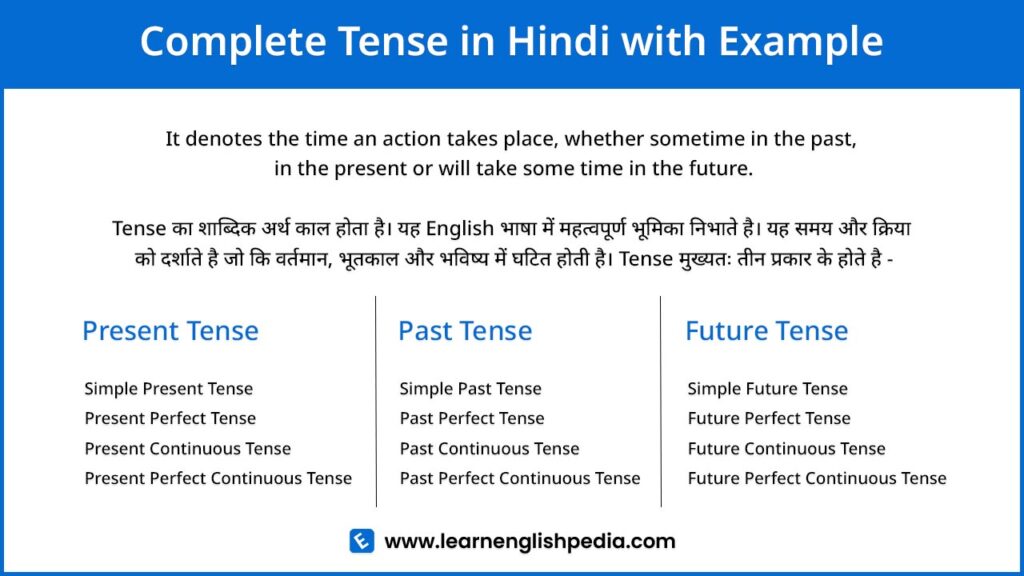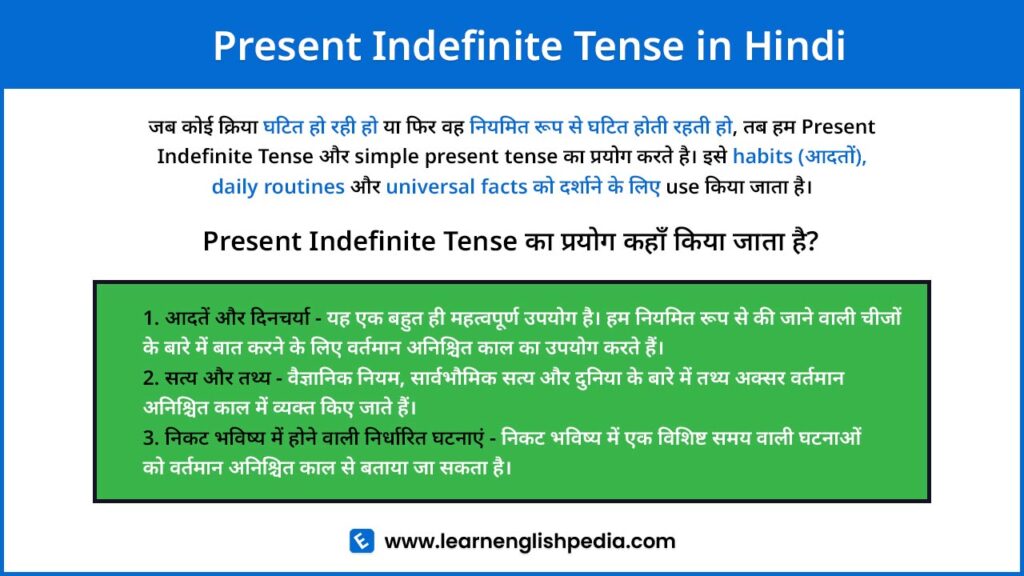इस article में हम Present Continuous Tense in hindi के बारे में जानेंगे। हम जानेंगे कि present continuous tense की पहचान क्या है, उसका structure क्या है और उसके उदाहरण क्या क्या है?
Present Continuous Tense in Hindi
जिस वाक्य के अंत में रहा है,रही है और रहे है आए, वह present continuous tense कहलाता है, जैसे – वह कल new delhi जा रहा है। (He is going to New Delhi tomorrow.)
Or
Present continuous tense हिंदी व्याकरण में उन क्रियाओं या घटनाओं को व्यक्त करने के लिए प्रयोग किया जाता है जो वर्तमान समय में घट रही हैं या किसी विशिष्ट समय अवधि के दौरान घटित हो रही हैं। इसका नाम ही इसके स्वरूप को स्पष्ट करता है।
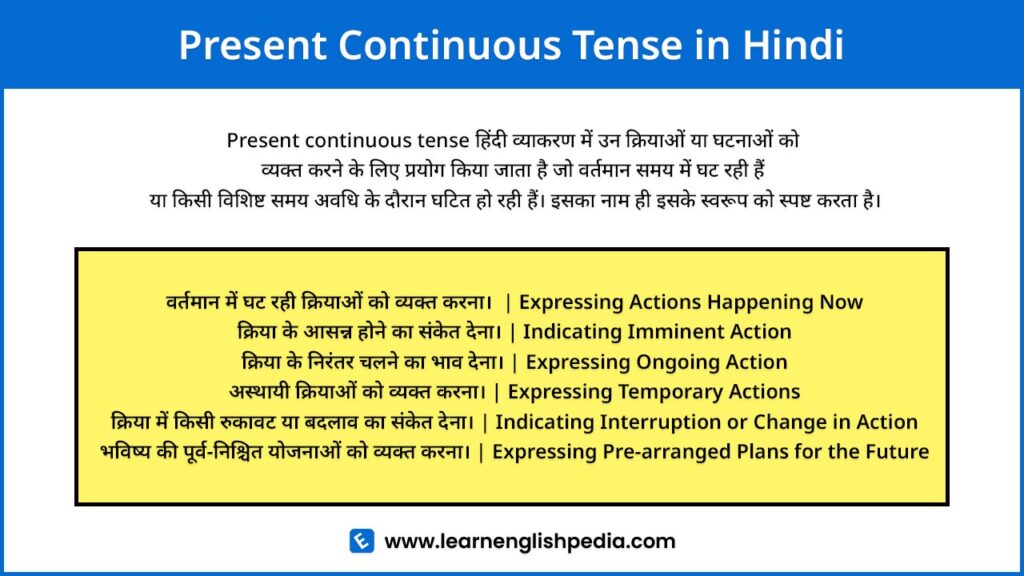
Main Use Present Continuous Tense in Hindi
Present Continuous Tense हिंदी व्याकरण का एक महत्वपूर्ण अंग है। इसका प्रयोग उन क्रियाओं या घटनाओं के लिए किया जाता है जो वर्तमान समय में घट रही हैं या किसी विशिष्ट समय अवधि के दौरान घटित हो रही हैं।
Present Continuous Tense का प्रयोग कहाँ कहाँ किया जाता है, इस बारे में निचे पढ़िए।
Expressing Actions Happening Now
Present continuous tense का सबसे बुनियादी उपयोग वर्तमान समय में हो रही क्रियाओं को बताना है। इन क्रियाओं की अवधि कुछ second से लेकर घंटों या दिनों तक भी हो सकती है।
Example –
- I am eating food. – मैं खाना खा रहा हूँ।
- She is watching TV. – वह टीवी देख रही है।
- Children are playing in the park. – बच्चे पार्क में खेल रहे हैं।
- We are waiting for you. – हम आपका इंतज़ार कर रहे हैं।
- It is raining. – बारिश हो रही है।
Indicating Imminent Action
कभी-कभी, वर्तमान सतत काल का उपयोग किसी ऐसी क्रिया को व्यक्त करने के लिए किया जाता है जो अभी होने वाली है।
Example –
- She is about to do her homework. – वह अपना होमवर्क करने वाली है।
- । am leaving now. – मैं अभी निकल रहा हूँ।
- The train is coming shortly. – Train कुछ ही देर में आने वाली है।
Expressing Ongoing Action
Present Continuous Tense का उपयोग उन क्रियाओं को व्यक्त करने के लिए भी किया जाता है जो किसी अवधि में लगातार या निरंतर रूप से चल रही हों।
Example –
- I am preparing for exams this week. – मैं इस हफ्ते परीक्षाओं की तैयारी कर रहा हूँ।
- She is writing a new novel these days. – वह इन दिनों नया उपन्यास लिख रही है।
- The machines are running in the factory. – कारखाने में मशीनें चल रही हैं।
Expressing Temporary Actions
कभी-कभी, present continuous tense का उपयोग उन क्रियाओं को व्यक्त करने के लिए किया जाता है जो सामान्य रूप से नहीं होती हैं, लेकिन फिलहाल हो रही हैं।
Example –
- Decoration for Diwali is happening. – दीवाली की सजावट चल रही है।
- She is staying with her parents this month. – वह इस महीने अपने माता-पिता के पास रह रही है।
- We are staying at a hotel. – हम होटल में ठहरे हुए हैं।
Indicating Interruption or Change in Action
Present continuous tense का उपयोग क्रिया में किसी रुकावट या अस्थायी बदलाव को व्यक्त करने के लिए भी किया जा सकता है।
Example –
- The phone suddenly rang. – अचानक फोन ब बज उठा।
- I am drinking tea while working. – मैं काम करते समय चाय पी रहा हूँ।
- She stopped while singing. – वह गाना गाते समय रुक गई।
Expressing Pre-arranged Plans for the Future
ऐसी योजनाओं को व्यक्त करने के लिए भी present continuous tense का प्रयोग किया जाता है जो भविष्य में किसी निश्चित समय पर होने वाली हों।
Example –
- We are going to a wedding tomorrow. – हम कल शादी में जा रहे हैं।
- She is going abroad next week. – वह अगले हफ्ते विदेश यात्रा पर जा रही है।
- The doctor is coming to the clinic at 5 pm. – डॉक्टर साहब शाम 5 बजे क्लिनिक पर आ रहे हैं।
Present Continuous Tense हिंदी व्याकरण में एक बहुउपयोगी काल है। इसका सही प्रयोग क्रियाओं को स्पष्ट और सटीक रूप से व्यक्त करने में सहायक होता है। अभ्यास के साथ आप present continuous tense का प्रयोग आसानी से सीख सकते हैं।
Sentence Structures
Present continuous tense का मुख्य रूप चार प्रकार से विभाजन किया गया है, जिनके बारे में आप निचे पढ़ सकते है।
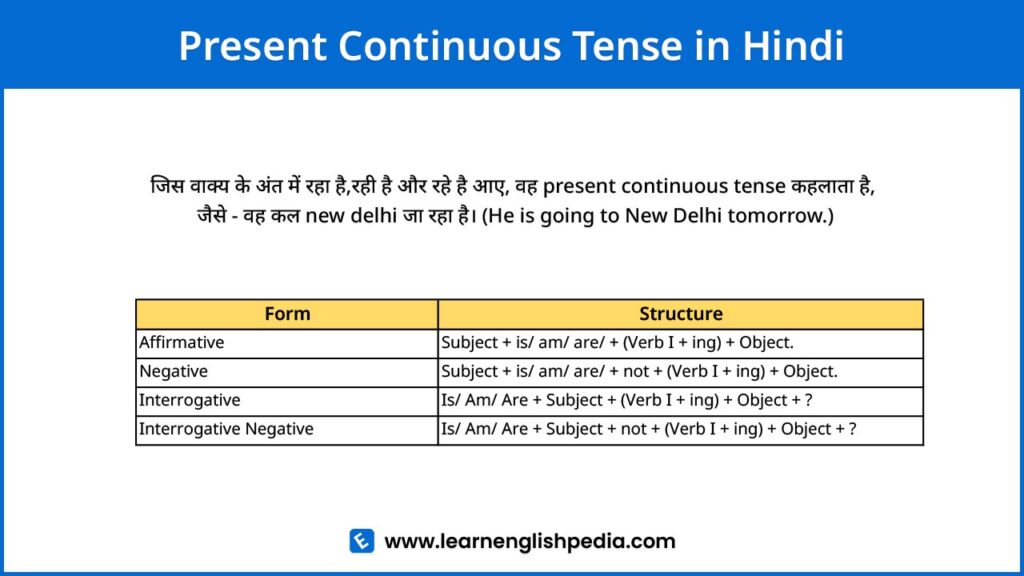
Affirmative Forms
Present continuous tense के affirmative sentences में helping verb – is, am, are का प्रयोग किया जाता है और verb की 1st form के साथ ing का प्रयोग किया जाता है।
Structure –
Subject + is/ am/ are/ + (Verb I + ing) + Object.
He, she, it और any name (singular number third person) के साथ ‘is’, I के साथ am और we, you, they और plural number के साथ ‘are’ का प्रयोग किया जाता है।
Example –
- I am going to school. – मैं स्कूल जा रहा हूँ।
- He is going to school. – वह स्कूल जा रहा है।
- She is going to school. – वह स्कूल जा रही है।
- We are going to school. – हम स्कूल के लिए जा रहे हैं।
- You are going to school. – तुम स्कूल जा रहे हो।
- They are going to school. – वे स्कूल जा रहे है।
Negative Forms –
Present continuous tense के negative sentences में helping verb – is, am, are का प्रयोग किया जाता है और verb की 1st form के साथ ing का प्रयोग किया जाता है।
Structure –
Subject + is/ am/ are/ + not + (Verb I + ing) + Object.
Example –
- I am not going to school. – मैं स्कूल नहीं जा रहा हूं।
- He is not going to school. – वह स्कूल नहीं जा रहा है।
- She is not going to school. – वह स्कूल नहीं जा रही है।
- We are not going to school. – हम स्कूल नहीं जा रहे हैं।
- You are not going to school. – आप स्कूल नहीं जा रहे हैं।
- They are not going to school. – वे स्कूल नहीं जा रहे हैं।
Interrogative Forms –
Present continuous tense के interrogative sentences में helping verb – is, am, are का प्रयोग subject के पहले किया जाता है और verb की 1st form के साथ ing का प्रयोग किया जाता है।
Structure –
Is/ Am/ Are + Subject + (Verb I + ing) + Object + ?
Example –
- Am I going to school? – क्या मैं स्कूल जा रहा हूँ?
- Is he going to school? – क्या वह स्कूल जा रहा है?
- Is she going to school? – क्या वह स्कूल जा रही है?
- Are we going to school? – क्या हम स्कूल जा रहे हैं?
- Are you going to school? – क्या आप स्कूल जा रहे हैं?
- Are they going to school? – क्या वे स्कूल जा रहे हैं?
Interrogative Negative Forms –
Present continuous tense के interrogative negative sentences में helping verb – is, am, are का प्रयोग subject के पहले और बाद में not का प्रयोग किया जाता है और verb की 1st form के साथ ing का प्रयोग किया जाता है। Interrogative negative sentences के दो sentence structure होते है जहाँ not का प्रयोग subject के बाद में और not का प्रयोग helping verb के साथ किया जाता है।
Structure –
Is/ Am/ Are + Subject + not + (Verb I + ing) + Object + ?
OR
Isn’t/ Aren’t + Subject + (Verb I + ing) + Object + ?
Example –
- Am I not going to school? – क्या मैं स्कूल नहीं जा रहा हूँ?
- Is he not going to school? – क्या वह स्कूल नहीं जा रहा है?
- Is she not going to school? – क्या वह स्कूल नहीं जा रही है?
- Are we not going to school? – क्या हम स्कूल नहीं जा रहे हैं?
- Are you not going to school? – क्या आप स्कूल नहीं जा रहे हैं?
- Are they not going to school? – क्या वे स्कूल नहीं जा रहे हैं?
Read More: Idioms Starting with A
Note – Ing का प्रयोग करते समय आपको कुछ बातो का ध्यान भी रखना आवशयक है।
- अगर verb का आखिरी letter ‘e’ हो तो,तो ‘e’ को हटाकर ‘ing’ काप्रयोग किया जाता है, जैसे – come + ing = coming, take + ing = taking, drive + ing = driving (Exception – be + ing = being)
- अगर verb के अंतिम letters ‘ee’, ‘oe’ और ‘ye’ हो तो इनमे कोई परिवर्तन नहीं किया जाता है और ‘ing’ का प्रयोग इनके साथ ही किया जाता है, जैसे – agree + ing = agreeing, shoe + ing = shoeing, eye + ing = eyeing, see + ing = seeing
- अगर verb के अंतिम letters ‘ie’ हो तो इन्हे ‘y’ में बदलकर इनके साथ ‘ing’ का प्रयोग किया जाता है, जैसे – die + ing = dying, lie + ing = lying और अगर verb का अंतिम letter ‘y’ हो तो इसके साथ ही ‘ing’ का प्रयोग किया जायेगा, जैसे – hurry + ing = hurrying
- अगर verb के आखिर letter से पहले कोई vowel हो तो आख़िरी का letter का double करे और इसके साथ ing का प्रयोग करे। ध्यान रहे w, r और y को double नहीं किया जायेगा। जैसे – sit + ing = sitting, win +ing = winning, put + ing = putting. (Exception–pardoning, ironing, opening, burning)
- अगर verb का आखिरी letter ‘c’ हो तो ‘c’ के बाद ‘k’ का प्रयोग किया जायेगा, जैसे – mimic + ing = mimicking
Present Continuous Tense Examples in Hindi
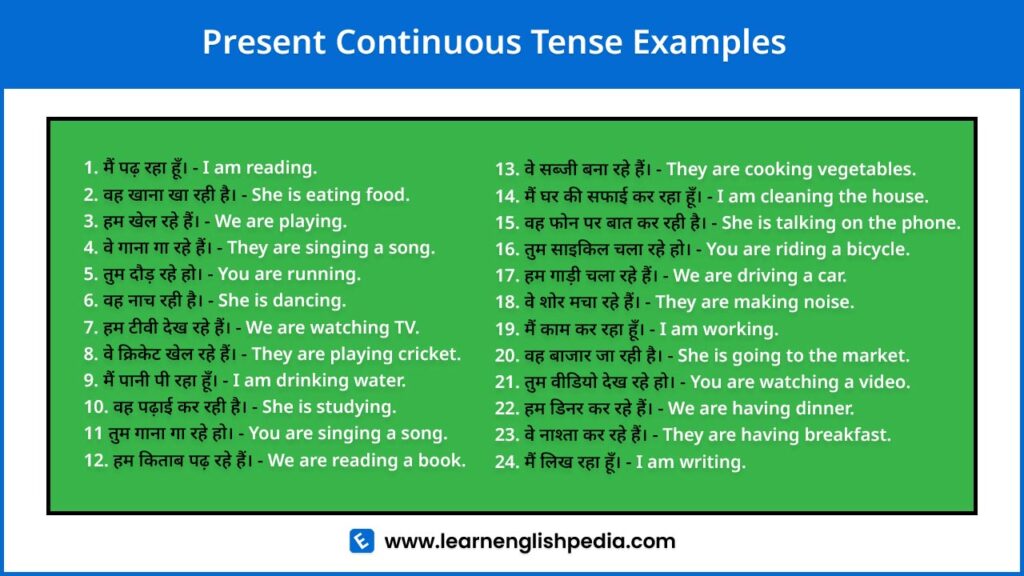
- मैं पढ़ रहा हूँ। – I am reading.
- वह खाना खा रही है। – She is eating food.
- हम खेल रहे हैं। – We are playing.
- वे गाना गा रहे हैं। – They are singing a song.
- तुम दौड़ रहे हो। – You are running.
- वह नाच रही है। – She is dancing.
- हम टीवी देख रहे हैं। – We are watching TV.
- वे क्रिकेट खेल रहे हैं। – They are playing cricket.
- मैं पानी पी रहा हूँ। – I am drinking water.
- वह पढ़ाई कर रही है। – She is studying.
- तुम गाना गा रहे हो। – You are singing a song.
- हम किताब पढ़ रहे हैं। – We are reading a book.
- वे सब्जी बना रहे हैं। – They are cooking vegetables.
- मैं घर की सफाई कर रहा हूँ। – I am cleaning the house.
- वह फोन पर बात कर रही है। – She is talking on the phone.
- तुम साइकिल चला रहे हो। – You are riding a bicycle.
- हम गाड़ी चला रहे हैं। – We are driving a car.
- वे शोर मचा रहे हैं। – They are making noise.
- मैं काम कर रहा हूँ। – I am working.
- वह बाजार जा रही है। – She is going to the market.
- तुम वीडियो देख रहे हो। – You are watching a video.
- हम डिनर कर रहे हैं। – We are having dinner.
- वे नाश्ता कर रहे हैं। – They are having breakfast.
- मैं लिख रहा हूँ। – I am writing.
- वह सो रही है। – She is sleeping.
- तुम सवाल पूछ रहे हो। – You are asking a question.
- हम चर्चा कर रहे हैं। – We are discussing.
- वे यात्रा कर रहे हैं। – They are traveling.
- मैं बगीचे में काम कर रहा हूँ। – I am working in the garden.
- वह संगीत सुन रही है। – She is listening to music.
- तुम चित्र बना रहे हो। – You are drawing a picture.
- हम पार्टी में जा रहे हैं। – We are going to the party.
- वे किताबें खरीद रहे हैं। – They are buying books.
- मैं फिल्म देख रहा हूँ। – I am watching a movie.
- वह दूध पी रही है। – She is drinking milk.
- तुम नोट्स बना रहे हो। – You are taking notes.
- हम योजना बना रहे हैं। – We are planning.
- वे ईमेल भेज रहे हैं। – They are sending an email.
- मैं कविता लिख रहा हूँ। – I am writing a poem.
- वह योग कर रही है। – She is doing yoga.
- तुम चित्र खींच रहे हो। – You are taking a picture.
- हम कंप्यूटर पर काम कर रहे हैं। – We are working on the computer.
- वे पैदल चल रहे हैं। – They are walking.
- मैं नाश्ता बना रहा हूँ। – I am making breakfast.
- वह सफाई कर रही है। – She is cleaning.
- तुम गाड़ी धो रहे हो। – You are washing the car.
- हम यात्रा की तैयारी कर रहे हैं। – We are preparing for the trip.
- वे कहानियाँ सुना रहे हैं। – They are telling stories.
- मैं घर जा रहा हूँ। – I am going home.
- वह बर्तन धो रही है। – She is washing dishes.
- तुम मदद कर रहे हो। – You are helping.
- हम संगीत बजा रहे हैं। – We are playing music.
- वे फूल लगा रहे हैं। – They are planting flowers.
- मैं सोच रहा हूँ। – I am thinking.
- वह उपहार पैक कर रही है। – She is packing gifts.
- तुम आराम कर रहे हो। – You are resting.
- हम समस्या सुलझा रहे हैं। – We are solving a problem.
- वे मिठाई खा रहे हैं। – They are eating sweets.
- मैं कविता सुन रहा हूँ। – I am listening to poetry.
- वह फिल्म देख रही है। – She is watching a movie.
- तुम लेक्चर सुन रहे हो। – You are listening to a lecture.
- हम समाचार पढ़ रहे हैं। – We are reading the news.
- वे सवाल पूछ रहे हैं। – They are asking questions.
- मैं नई भाषा सीख रहा हूँ। – I am learning a new language.
- वह खरीदारी कर रही है। – She is shopping.
- तुम मस्ती कर रहे हो। – You are having fun.
- हम दौड़ रहे हैं। – We are running.
- वे नौकरी के लिए आवेदन कर रहे हैं। – They are applying for a job.
- मैं पत्र लिख रहा हूँ। – I am writing a letter.
- वह अपनी माँ से बात कर रही है। – She is talking to her mother.
- तुम नए दोस्त बना रहे हो। – You are making new friends.
- हम नए गीत सीख रहे हैं। – We are learning new songs.
- वे बारिश में खेल रहे हैं। – They are playing in the rain.
- मैं कविता पढ़ रहा हूँ। – I am reading a poem.
- वह कुछ खरीद रही है। – She is buying something.
- तुम अपना काम कर रहे हो। – You are doing your work.
- हम अपना घर साफ कर रहे हैं। – We are cleaning our house.
- वे बच्चों को पढ़ा रहे हैं। – They are teaching children.
- मैं योग कर रहा हूँ। – I am doing yoga.
- वह स्कूल जा रही है। She is going to school.
Present Continuous Tense in Hindi Exercise
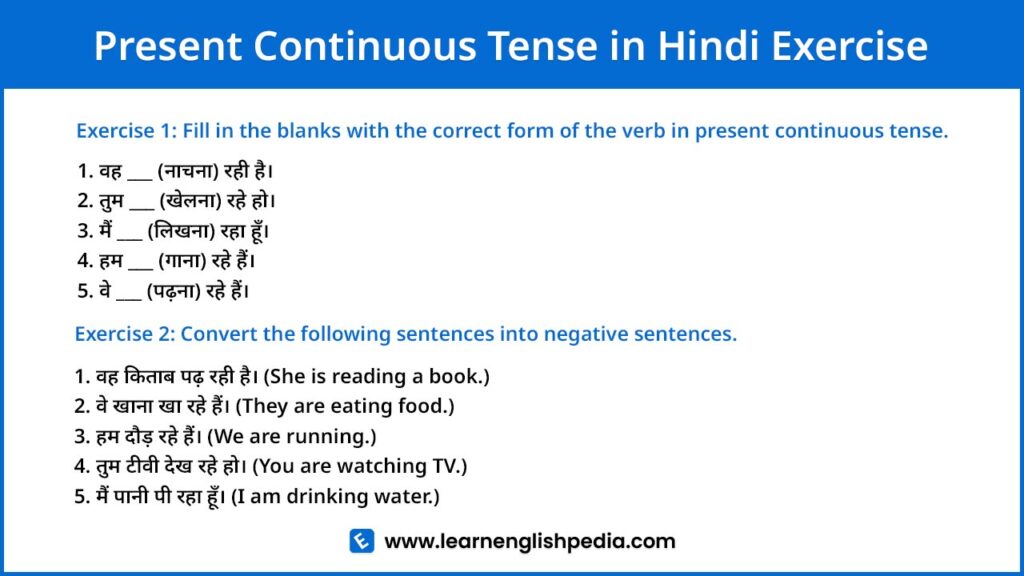
Exercise 1: Fill in the blanks with the correct form of the verb in present continuous tense.
- वह ___ (नाचना) रही है।
- तुम ___ (खेलना) रहे हो।
- मैं ___ (लिखना) रहा हूँ।
- हम ___ (गाना) रहे हैं।
- वे ___ (पढ़ना) रहे हैं।
Answers:
- नाच रही
- खेल रहे
- लिख रहा
- गा रहे
- पढ़ रहे
Exercise 2: Convert the following sentences into negative sentences.
- वह किताब पढ़ रही है। (She is reading a book.)
- वे खाना खा रहे हैं। (They are eating food.)
- हम दौड़ रहे हैं। (We are running.)
- तुम टीवी देख रहे हो। (You are watching TV.)
- मैं पानी पी रहा हूँ। (I am drinking water.)
Answers:
- वह किताब नहीं पढ़ रही है।
- वे खाना नहीं खा रहे हैं।
- हम नहीं दौड़ रहे हैं।
- तुम टीवी नहीं देख रहे हो।
- मैं पानी नहीं पी रहा हूँ।
Exercise 3: Convert the following sentences into interrogative sentences.
- मैं गाना गा रहा हूँ। (I am singing a song.)
- वह साइकिल चला रही है। (She is riding a bicycle.)
- हम काम कर रहे हैं। (We are working.)
- वे खेल रहे हैं। (They are playing.)
- तुम खाना बना रहे हो। (You are cooking food.)
Answers:
- क्या मैं गाना गा रहा हूँ?
- क्या वह साइकिल चला रही है?
- क्या हम काम कर रहे हैं?
- क्या वे खेल रहे हैं?
- क्या तुम खाना बना रहे हो?
Exercise 4: Describe what people are doing in the following situations.
- (A person reading a newspaper)
- (Children playing in the park)
- (Someone cooking in the kitchen)
- (A woman dancing)
- (Men working in the office)
Answers:
- वह अखबार पढ़ रहा है। (He is reading a newspaper.)
- बच्चे पार्क में खेल रहे हैं। (Children are playing in the park.)
- वह रसोई में खाना बना रहा है। (He is cooking in the kitchen.)
- वह नाच रही है। (She is dancing.)
- पुरुष कार्यालय में काम कर रहे हैं। (Men are working in the office.)
यह अभ्यास और उदाहरण हिंदी में वर्तमान निरंतर काल के प्रयोग को समझने में मदद करेंगे। और वाक्य बनाकर और उन्हें सकारात्मक, नकारात्मक और प्रश्नवाचक रूपों में बदलकर अभ्यास करें ताकि दक्षता प्राप्त हो सके।

